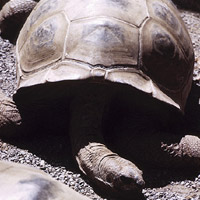Reptiles - Snapping Turtle
 Region:
North America Region:
North America
Class: Reptilia
Order: Chelonia
Family: Chelydridae
Genus: Chelydra
Scientific Name: Chelydra serpentina serpentina
Description: Length of carapace: up to 40 cm. Weight:
up to 35 kg. The snapping turtle has a rough carapace,
markedly serrated at the rear edge. This becomes smooth
with age and older individuals are usually covered with
algae and easily mistaken for underwater rocks. The plastron
is almost cross-shaped and very small, leaving much of
their underparts unprotected as they are unable to tuck
their heads and legs back into their shell to avoid predators.
Thus, the snapping turtle will adopt an aggressive stance
and lunge at potential predators when it feels threatened
on land. When in the water it is far more likely to flee
and contrary to popular belief, a swimmer is not likely
to be bitten. The head is large, the snout short and both
tips of the powerful jaws are sharply hooked. There are
two barbels on its chin and the skin on its neck is rough
and warty. Its tail is thick at the base, as long or longer
than the carapace and is covered with warty tubercles.
The colour ranges from light brown to almost black.
Distribution: From Nova Scotia, New Brunswick and southern
Quebec west to southeastern Alberta and southward east
of the Rocky Mountains to southern Georgia and the Texas
coast in the United States. It is found from sea level
to altitudes over 2,000 m in North America.
Habitat: Generally large bodies of fresh water, both lakes
and rivers, but it may also be found in small streams,
ponds and marshes, preferring slow-moving water with a
soft muddy bottom and plenty of aquatic vegetation or
submerged brush and tree trunks for cover. It is mostly
found in shallow waters but it may also occur along the
edges of deep lakes and rivers.
Food: Chiefly carnivorous, eating fish, fowl, frogs, insects,
crustaceans and any other small animals that it can catch.
It will also eat some vegetation, especially when young.
Carrion is often consumed. Small prey is swallowed whole
but larger food is held in the mouth and torn apart with
its long foreclaws. Feeding usually occurs underwater
but may occur on land.
Reproduction and Development: The nesting period is from
May or earlier in the south to mid-June or later in the
north. The female usually lays 20-40 eggs (a clutch of
104 was recorded in the United States) in soft earth,
sand or gravel. She will dig a flask-shaped nest with
her hind feet on a sandy beach or field, or occasionally
an abandoned muskrat lodge will be used. The half white,
half pinkish eggs are round with a hard, brittle shell,
23-33 mm in diameter and 5-15 g in weight. They are highly
relished by raccoons and other predators. Incubation is
anywhere from 55 to 125 days, with between 75 and 95 being
the most common. During this period the temperature of
the incubating eggs determines the sex of the hatching
turtles. Life span of a snapping turtle is about 28-40
years.
Adaptations: The snapping turtle is one of the more aquatic
species of turtle, spending most of its time lying on
the bottom buried in the mud in the shallow water, with
only its eyes and nostrils exposed. When moving in the
water it usually prefers to walk along the bottom or float
lazily just beneath the water surface with just its eyes
and nostrils exposed, but it does have webbed toes and
can swim rapidly when frightened. Most enter hibernation
by late October, burrowing into the mud or occupying muskrat
lodges or burrows. They become active again in March in
the south, and as late as May in Canada.
Threats: Man is the chief predator of the adults, killing
them both for food and due to misguided beliefs that they
attack swimmers and prey on game fish and the duck population.
Many animals, birds and reptiles eat the eggs and the
young; alligators, otters, coyotes and bears eat the adults.
Status: Common
References: "In Praise of Turtles" by Bob Johnson
"The Turtles of Canada" by Barbara Froom "Turtles
of the United States and Canada" by C.H. Ernst, J.E.
Lovich, and R.W.Barbour |
|
|
